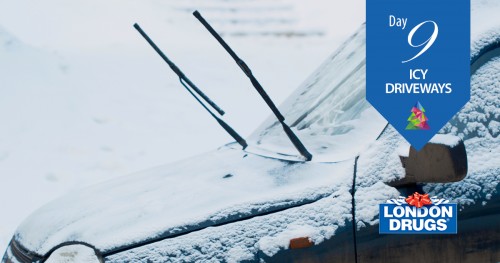9 icy driveways

<< 10 Marthas crafting | ALL | 8 families coping >> |
7 Myths About Warming Your Car Up In Winter
It’s February 2nd of yet another brutal Canadian winter, and the mercury hasn’t risen above –10 Celsius in a fortnight. Brrr. Six o’clock Tuesday morning finds you shivering in the driver’s seat of your car, which has sat on the driveway since the evening before. As you turn the ignition, the car roars to life. Pop quiz: To avoid damaging the engine, should you let the car warm up for a) 2 minutes, b) 5 minutes, or c) 10 minutes.
The answer? None of the above. Idling your car in cold weather is—what’s the phrase?—totally unnecessary. Don’t take our word for it, though. Here’s master mechanic Rob Maier: “Because of the efficiency of modern fuel injection, which eliminated carburetors and chokes, you don’t really need to idle your car. My truck has 250,000 kilometers on it, and I just throw it into gear and go.”
Here are 7 myths about idling your car in cold weather (with a handy assortment of delightfully toasty truths):
- The driver’s got to warm up before he can hit the road. Hmmm, getting warm by sitting still? You know what warms up a car even faster than idling? Driving. If you’re concerned about physical comfort—and who isn’t?—get moving. Driving is a much faster way to get the heat circulating in the car, return feeling to your fingers and toes.
- A couple of minutes of idling doesn’t cost much. Actually, idling for longer than 10 seconds is putting the hurt on both you and the environment. After 10 seconds, you waste more money running the engine than restarting it. Word to the wise: If you idle your car five minutes a day for a year, you’ll waste 75 litres of gasoline—which produces 200 kilograms of carbon dioxide AND costs you at least $90.
- Idling is gentle on the engine in cold weather. Sorry, wrong again. According to the Anti-Idling Primer, idling forces an engine “to operate in a very inefficient and gasoline-rich mode that, over time, can degrade the engine’s performance and reduce mileage.”
- Idling in the garage is safe. You’ve seen House of Cards, right? Idling a car in a garage is a terrible idea, even with the door open. It’s dangerous and exposes the driver to carbon monoxide and other noxious gases. And if the garage is attached, those fumes can also enter the house.
- Remote starters are better than block heaters. Take it from Lori Strothard, an expert from the frosty climes of Waterloo, Ontario: “Remote starters often cause people to warm up their cars for five to 15 minutes, which is unnecessary.” A block heater is designed to heat the engine and can be set to turn on one or two hours before driving. It costs under $30, and does the trick in very cold climates.
- “Ah, just leave it running—I’m only dashing in and out.”
Natural Resources Canada points out that quick errand idling is another way to waste gas and pollute both your town and the planet. “Leaving your engine running is hard on your pocketbook, produces greenhouse gas emissions and is an invitation to car thieves,” the agency says. - Idling isn’t such a threat to public health. Come, come. Exhaust is hazardous to human health, especially children’s. (Studies show that children’s IQ levels are lower when they live near major roads with lots of traffic.) The air pollution from tailpipes is linked to increased rates of cancer, heart and lung disease, asthma and allergies. Idling is the second-hand smoke of the outdoors.
[More at Yahoo Autos Canada]

